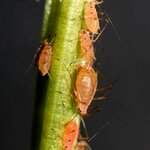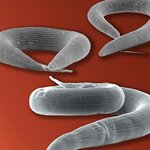Microbiology

Even though scientists have successfully sequenced the human genome, they still lack a clear picture of exactly how coding and non-coding DNA sequences function together, or how genomes evolve over time. This has been particularly problematic for scientists who use genetic similarities to characterize evolutionary divergence. Historically, the processes of genetic evolution and genome degradation have been difficult to study due to technological limitations and lack of accurate historical records for species.
Researchers are now beginning to understand this process using symbiotic bacteria as…

In terms of diversity and sheer numbers, the microbes occupying the human gut easily dwarf the billions of people inhabiting the Earth. Numbering in the tens of trillions and representing many thousands of distinct genetic families, this microbiome, as it's called, helps the body perform a variety of regulatory and digestive functions, many still poorly understood.
How this microbial mélange may be linked to body weight changes associated with morbid obesity is a relevant and important clinical question that has received recent attention. Now, a new study suggests that the composition…

Even 150 years after Charles Darwin’s epochal On the Origin of Species many questions about the molecular basis of evolution are still waiting for answers.
How are signaling pathways changed by genes and by the environment enabling the development of new species?
A group of scientists at the Max Planck Institute for Developmental Biology in Tübingen, Germany, are striving to decode the molecular basis of parasitism and their objects of research are nematode worms. Do the dauer stages which occur in certain nematodes and the infective larvae of their parasitic cousins share a common…

New information has shed light upon those mushrooms in your dinner, proving that they may add more to your health than just nutrition.
According to a recent study conducted by researchers at Kansai Medical University in Osaka, Japan, the mushroom compound AHCC (Active Hexose Correlated Compound) can increased immune system function by increasing the number of dendritic cells (DCs) which carry out a key role in an active immune system. DCs are responsible for recognizing abnormal or foreign objects, cells or particles in our bodies and presenting them to T-cells which act to destroy…

If you're a mouse and you like fatty foods, we have good news for you. Researchers at the University of California, Berkeley have identified a new enzyme that helps control the breakdown of fat and the mice that have had this enzyme disabled remained lean despite eating a high-fat diet and losing a hormone that suppresses appetite.
The enzyme in the spotlight, adipose-specific phospholipase A2 (AdPLA), is found in abundance only in fat tissue. AdPLA sets off a chain of events that increases levels of a signaling molecule called prostaglandin E2 (PGE2), which suppresses the breakdown of…

People have been making cheese for 8,000 years but it seems we still don't know all there is to know about the bacteria responsible for turning milk into cheese. An international research team has identified a new line of bacteria they believe adds flavor to some of the world's most exclusive cheeses.
The team used DNA fingerprinting techniques to identify eight previously undiscovered microbes in the French cheese Reblochon.
One of France's great mountain cheeses, Reblochon hails back to the Middle-Ages, when farmers in the mountains of Haute Savoie used to pay their taxes with…

With cold and flu season in full swing, the fact that viruses and bacteria rapidly 'evolve' is apparent with every sneeze, sniffle, and cough. A new report in The FASEB Journal seeks to explain how humans keep up with microbes by rearranging the genes that make antibodies to foreign invaders. This research fills a significant gap in our understanding of how the immune system helps us survive.
When the body encounters a foreign invader, like a virus or bacterium, it immediately begins to find a way to neutralize it by means of cellular or antibody-mediated defenses. Part of the process…

Researchers have developed a new, highly efficient way to pair up cells so they can be fused together into a hybrid cell. The new technique should make it much easier for scientists to study what happens when two cells are combined. For example, fusing an adult cell and an embryonic stem cell allows researchers to study the genetic reprogramming that occurs in such hybrids.
The researchers, led by a collaboration between Joel Voldman, associate professor of electrical engineering and computer science at MIT, and Rudolf Jaenisch, professor of biology and a member of the Whitehead…

Researchers at The Ohio State University Comprehensive Cancer Center have discovered that a molecule implicated in leukemia and lung cancer is also important in muscle repair and in a muscle cancer that strikes mainly children.
The study shows that immature muscle cells require the molecule, called miR-29, to become mature, and that the molecule is nearly missing in cells from rhabdomyosarcoma, a cancer caused by the proliferation of immature muscle cells.
Cells from human rhabdomyosarcoma tumors showed levels of the molecule that were 10 percent or less of those in normal muscle…

Peering at structures only atoms across, researchers writing in Cell have identified the clockwork that drives a powerful virus nanomotor. Bonus: Because of the motor's strength - to scale, it is twice that of an automobile - the new findings could also inspire engineers designing sophisticated nanomachines.
But back on viruses, because a number of virus types may possess a similar motor, including the virus that causes herpes, the results may also assist pharmaceutical companies developing methods to sabotage virus machinery.
The virus in the study, called T4, is not a common…